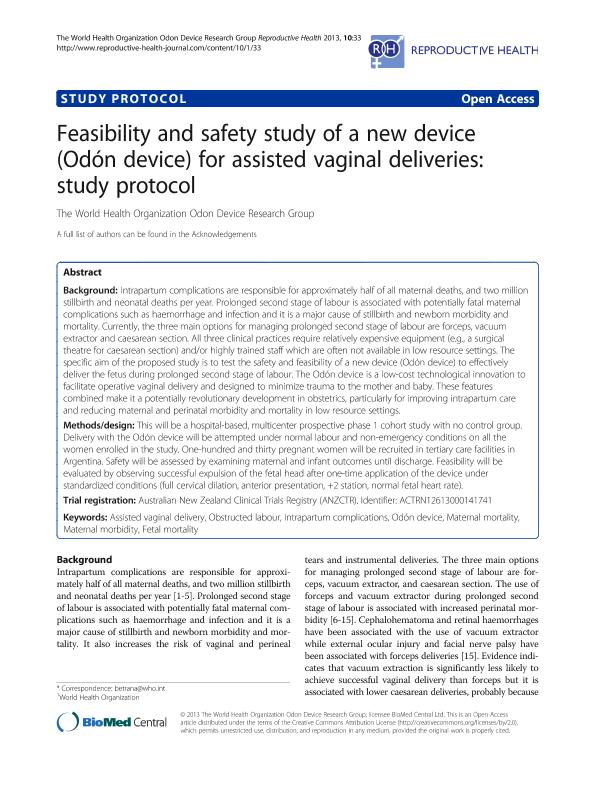Artículo
Feasibility and safety study of a new device (Odón device) for assisted vaginal deliveries: study protocol
Schvartzman, Javier A.; Krupitzki, Hugo Bernardo ; Betran, Ana Pilar; Requejo, Jennifer; Bergel, Eduardo; Fiorillo, Angel Eduardo; Gadow, Enrique Curt
; Betran, Ana Pilar; Requejo, Jennifer; Bergel, Eduardo; Fiorillo, Angel Eduardo; Gadow, Enrique Curt ; Vizcaino, Francisco M.; Von Petery, Felicitas; Althabe, Fernando
; Vizcaino, Francisco M.; Von Petery, Felicitas; Althabe, Fernando ; Belizan, Jose
; Belizan, Jose ; Borruto, Franco; Boulvain, Michel; Di Renzo, Gian Carlo; Gülmezoglu , Metin; Hofmeyr, Justus; Judge, Kevin; Leung, Tak Yeung; Nguyen, My Huong; Saugstad, Ola Didrik; Temmerman, Marleen; Treisser, Alain; Vayena, Effy; Merialdi, Mario
; Borruto, Franco; Boulvain, Michel; Di Renzo, Gian Carlo; Gülmezoglu , Metin; Hofmeyr, Justus; Judge, Kevin; Leung, Tak Yeung; Nguyen, My Huong; Saugstad, Ola Didrik; Temmerman, Marleen; Treisser, Alain; Vayena, Effy; Merialdi, Mario
 ; Betran, Ana Pilar; Requejo, Jennifer; Bergel, Eduardo; Fiorillo, Angel Eduardo; Gadow, Enrique Curt
; Betran, Ana Pilar; Requejo, Jennifer; Bergel, Eduardo; Fiorillo, Angel Eduardo; Gadow, Enrique Curt ; Vizcaino, Francisco M.; Von Petery, Felicitas; Althabe, Fernando
; Vizcaino, Francisco M.; Von Petery, Felicitas; Althabe, Fernando ; Belizan, Jose
; Belizan, Jose ; Borruto, Franco; Boulvain, Michel; Di Renzo, Gian Carlo; Gülmezoglu , Metin; Hofmeyr, Justus; Judge, Kevin; Leung, Tak Yeung; Nguyen, My Huong; Saugstad, Ola Didrik; Temmerman, Marleen; Treisser, Alain; Vayena, Effy; Merialdi, Mario
; Borruto, Franco; Boulvain, Michel; Di Renzo, Gian Carlo; Gülmezoglu , Metin; Hofmeyr, Justus; Judge, Kevin; Leung, Tak Yeung; Nguyen, My Huong; Saugstad, Ola Didrik; Temmerman, Marleen; Treisser, Alain; Vayena, Effy; Merialdi, Mario
Fecha de publicación:
07/2013
Editorial:
BioMed Central
Revista:
Reproductive health
ISSN:
1742-4755
Idioma:
Inglés
Tipo de recurso:
Artículo publicado
Clasificación temática:
Resumen
Background Intrapartum complications are responsible for approximately half of all maternal deaths, and two million stillbirth and neonatal deaths per year. Prolonged second stage of labour is associated with potentially fatal maternal complications such as haemorrhage and infection and it is a major cause of stillbirth and newborn morbidity and mortality. Currently, the three main options for managing prolonged second stage of labour are forceps, vacuum extractor and caesarean section. All three clinical practices require relatively expensive equipment (e.g., a surgical theatre for caesarean section) and/or highly trained staff which are often not available in low resource settings. The specific aim of the proposed study is to test the safety and feasibility of a new device (Odón device) to effectively deliver the fetus during prolonged second stage of labour. The Odón device is a low-cost technological innovation to facilitate operative vaginal delivery and designed to minimize trauma to the mother and baby. These features combined make it a potentially revolutionary development in obstetrics, particularly for improving intrapartum care and reducing maternal and perinatal morbidity and mortality in low resource settings. Methods/design This will be a hospital-based, multicenter prospective phase 1 cohort study with no control group. Delivery with the Odón device will be attempted under normal labour and non-emergency conditions on all the women enrolled in the study. One-hundred and thirty pregnant women will be recruited in tertiary care facilities in Argentina. Safety will be assessed by examining maternal and infant outcomes until discharge. Feasibility will be evaluated by observing successful expulsion of the fetal head after one-time application of the device under standardized conditions (full cervical dilation, anterior presentation, +2 station, normal fetal heart rate).
Archivos asociados
Licencia
Identificadores
Colecciones
Articulos(SEDE CENTRAL)
Articulos de SEDE CENTRAL
Articulos de SEDE CENTRAL
Citación
Schvartzman, Javier A.; Krupitzki, Hugo Bernardo; Betran, Ana Pilar; Requejo, Jennifer; Bergel, Eduardo; et al.; Feasibility and safety study of a new device (Odón device) for assisted vaginal deliveries: study protocol; BioMed Central; Reproductive health; 10; 7-2013; 1-8
Compartir
Altmétricas



